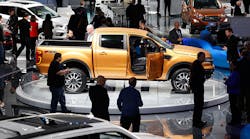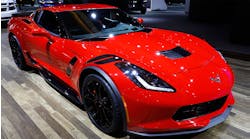AUTO SHOW: Dumped Cars, EV Dreams, and Other Lessons Learned in Detroit
The auto industry is undergoing its greatest upheaval since the advent of Henry Ford’s assembly line. The changes were as evident as the meteor and the sonic boom that rattled the frigid city of Detroit this week.
The rise of autonomy and electrification, and an exodus by Detroit’s hometown automakers from car segments loomed large at the North American International Auto Show. Here were some of the key takeaways:
Trucks Pay Bills
General Motors Co., Ford Motor Co. and Fiat Chrysler Automobiles NV stormed into this show with overhauled pickups. GM revealed an all-new Chevrolet Silverado pickup, Fiat Chrysler Automobiles NV introduced a new Ram 1500 and Ford Motor Co. revived the Ranger.
Their devotion to trucks makes sense. The biggest rigs now command luxury vehicle-like prices and bring in estimated profit of at least $10,000 apiece. GM predicted that a revamped pickup and sport utility vehicle lineup will help keep earnings in 2018 consistent with last year’s record, and that results will be even better in 2019.
Dead End
As trucks pad profit, Detroit automakers are discarding slow-selling passenger cars. Ford was the starkest it’s been in describing the direction it’s headed in this regard. It’s going to shift to a lower-volume, higher-margin lineup, a momentous pivot from a century spent selling sedans to the masses.
“We know we must evolve to be even more competitive and narrow our full line of nameplates in all markets, to a more focused lineup that delivers stronger, more profitable growth, with better returns,” said Jim Farley, Ford’s president of global markets.
Foreign Cars are King
Japanese and Korean automakers, meanwhile, will double down on diminutive models, bringing out refreshed coupes and sedans that should reinforce their hold on U.S. car segments.
South Korea’s Kia Motors Corp. debuted its redesigned Forte compact car, while Hyundai Motor Co. unveiled the second iteration of its three-door Veloster model. Even the shrinking full-size sedan segment saw some action, with Toyota rolling out an overhauled Avalon.
Time to Electrify
With regulators from Beijing to Sacramento cracking down on the internal combustion engine, there are few skeptics still questioning whether electric vehicles are in their future.
“There is no doubt in my mind that once range increases, prices drop and a fast-charging infrastructure is in place, customers will prefer electric powertrains against combustion engines,” Porsche Cars North America CEO Klaus Zellmer said at the Automotive News World Congress conference on Wednesday.
Fiat Chrysler CEO Sergio Marchionne, who once told a crowd in Washington he hoped they wouldn’t buy the money-losing Fiat 500e, has changed his tune. Carmakers have less than a decade to reinvent themselves or risk being commoditized, he told Bloomberg News in an exclusive interview.
“We’re all in now,” executive chairman Bill Ford told reporters on Sunday after Ford announced it will spend $11 billion to bring 40 electrified vehicles to market by 2022.
Will There Be Buyers?
But for all the planning carmakers are doing to add battery-powered models to their lineups in the years to come, they’re also sweating over whether consumer demand will be there.
“We cannot force them to buy, and we cannot force the government to change,” Nissan Motor Co. President Hiroto Saikawa said in an interview. “What we can do is to properly prepare.”
There still aren’t many electric vehicles to choose from today, Ford’s Farley said. That’s going to change, just as the regulatory environment gets more stringent. “It all points to a market that will be more robust,” Farley said. “But it is not here today. It is a leap of faith.”
By Keith Naughton, John Lippert, Tommaso Ebhardt and Elisabeth Behrmann, with assistance from Jamie Butters and Gabrielle Coppola.




